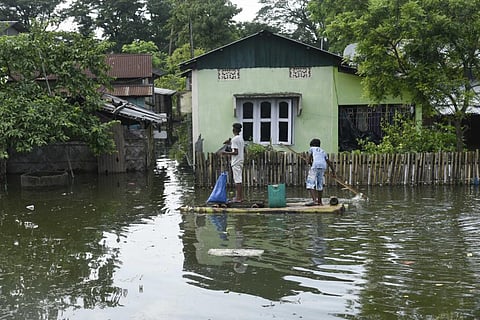How floods in Assam link to child trafficking
The unprecedented floods in Assam have left thousands homeless. Such deluges are not new to the people in the state, but the very nature and time coupled with its impact have trapped them, who are otherwise resilient to nature’s fury.
The very nature of this year’s flood surprised them. As a result, thousands had to take shelter at the relief camps along with their families.
The ill-fated flood, like other years, had led to massive loss of properties, livestock and livelihoods across the state. These devastations happened at a point when people were limping back to normalcy after the pandemic.
Flood is one such phenomenon that exacerbates poverty and potentially causes situations of conflict and instability. A significant part of the population in Assam faces a similar fate almost every year due to floods.
Loss of livelihood forces people to adopt harmful coping mechanisms. In any disaster, children remain the first casualty. With parents having limited or no income source, the vulnerability of children, especially girls, increase manifold.
Re-opening schools amid such flood fury is a distant cry as many of the school buildings are dilapidated and require immediate reconstruction, particularly in remote areas.
Most of the state’s children are not only out of their formal education but also out of the safety net provided by the schools.
Such a crisis aggravates their vulnerability to becoming either victims of child marriage, child labour or being displaced to some distant city or town with parental consent.
The parents are often lured with hefty payments by traffickers in the garb of employment agents.
Parents who are mostly busy taking care of their belongings and collecting food for their families in the relief camps find these offers most lucrative at such a critical phase.
The relief camps or the villages might see an increase in the organised gang of ‘touts’ to lure parents with false promises.
Most of the time, the agents offer a secured future for their children, especially girls, thereby entrapping them in the vicious cycle of human trafficking.
Assam, the gateway to the north-eastern parts of India, already has a high burden of missing children, according to National Crime Records Bureau data for 2019-20.
The devastating flood might have aggravated the vulnerability of the children across the remotest parts of the state, given their utter helplessness.
The need of the hour is to activate the local child protection committees at village and block levels. Child protection committees, with the delegation of authorities, ensure constant monitoring of children.
Sustained efforts need to be taken to reach out to school-going children, especially in tea gardens and other areas.
We should adopt various mechanisms to ensure continuity of their education and prevent them from falling prey to such touts, who now tacitly use social media to trap the tender minds.
Social security schemes function as a safety net for ensuring stable and steady support during a crisis such as illness, injury, unemployment, retirement and natural calamities.
Continuous awareness of social protection schemes is of utmost importance to tackle the root causes of the problems. Such schemes act as a push factor to harmful coping mechanisms within households.
This includes access to government-sponsored social protection schemes and building households’ capacity to respond to the crisis.
Children’s voices must be sought and integrated into planning on matters of public health, school and social services.
Children’s voices must be included, from local self-governance to state and national policy formulations.
Thus a concentrated pluralistic effort by government, civil society organisations and corporates is essential to take on this social evil and eradicate the same from society.
The authors are Chittapriyo Sadhu, Deputy Director-Program Management, Save the Children; Soumi Halder, Manager- Campaigns & Communication, Save the Children and Kritanjali Kashyap, Assistant Manager- Child Protection Projects, Save the Children.
Views expressed are the authors’ own and don’t necessarily reflect those of Down To Earth


